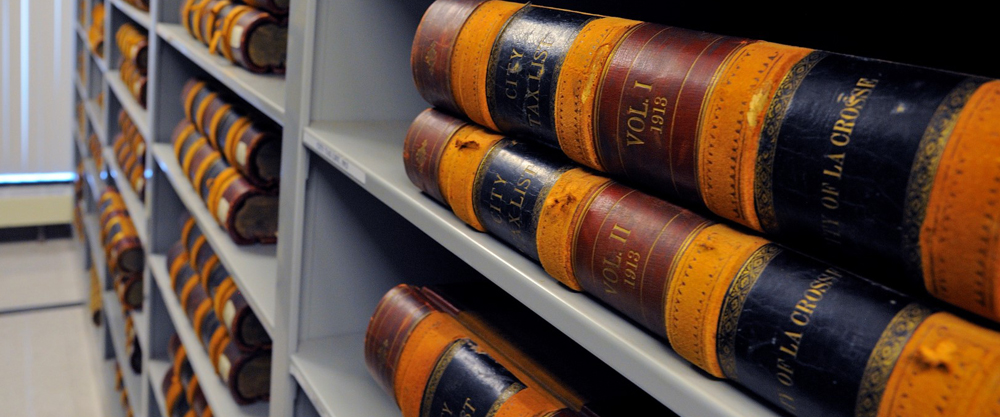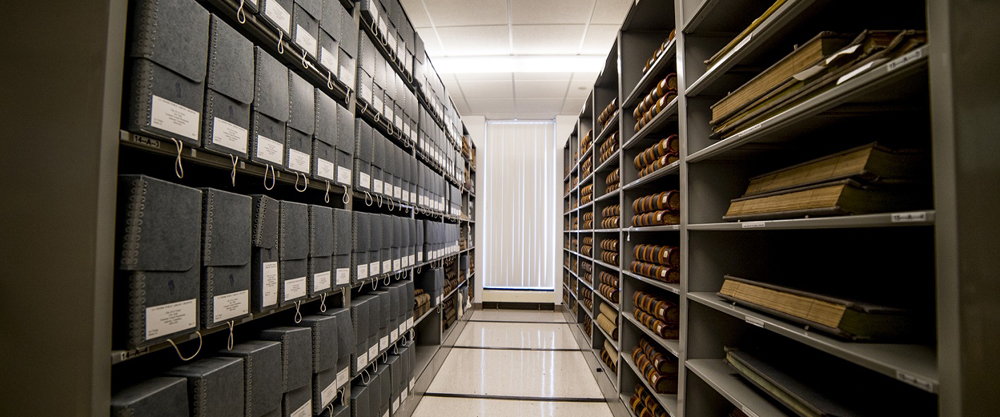LA CROSSE HISTORY
unbound
THE LA CROSSE AREA'S HISTORY, DIGITIZED
Glossary of Archival Terms

Unbound Collections
- Browse All Titles
- Formats
- General Histories
- Area Genealogy
- Accidents & Disasters
- Agriculture
- Archaeology
- Architecture
- Arts & Music
- Businesses & Industries
- Cemeteries
- Economy
- Education & Schools
- Events & Festivals
- Government
- Health & Healthcare
- Historic Sites
- Literature
- Military & War
- Natural Environment
- Neighborhoods
- Organizations
- Parks
- Peoples & Cultures
- Politics
- Press & News Media
- Religious Groups
- Sports & Recreation
- Transportation
Glossary of Archival Terms
Do librarians and archivists ever sound funny when they talk about collections and resources? Ever feel confused about what a finding aid is or is trying to convey? Look at our glossary of archival terms below to find answers to your questions!
To find more terms, go to the Society of American Archivists’ (SAA) Glossary of Archival and Records Terminology website.
Always feel free to ask a librarian or an archivist if you have any questions about these terms!
access
The ability to locate and use a repository’s materials physically and/or digitally, which can be found using tools made available, such as finding aids (see finding aid), catalogs, or websites like Unbound. Access sometimes requires legal permission, depending on the provenance (see provenance) of the records.
archival description
The notes in a finding aid (see finding aid) that detail a collection’s (see collection) contents and important information relating to the collection (e.g. title, creator, dates, as well as access or restrictions). The archival description is the product of organizing and analyzing a collection, which is done by an archivist.
Area Research Center (ARC)
A repository that holds public records (see public records) and collections (see collection) about and for the counties surrounding it. There are fourteen located around the state of Wisconsin. The ARC at UW-La Crosse Murphy Library Special Collections holds records for five area counties: Jackson, La Crosse, Monroe, Trempealeau, and Vernon. The ARCs do not own the materials they hold. They store them for local users, but the records are actually publicly owned by the State of Wisconsin. For more information about specific holdings, go to the UWL Murphy Library Special Collections and ARC webpage.
arrangement
The organization of an archival collection (see collection), which involves having complete understanding of and respect for the collection’s contents and provenance (see provenance). It is often based on the original order of the materials when they were donated to the repository. The arrangement is decided by the archivist while they process (see processing) a collection.
Related Terms
organization scheme, another term for arrangement
box
The container in which archival materials are held. Unless they are not processed (see processing), these materials are in a particular order and inside labeled folders (see folder) to keep organization and to respect the material’s provenance (see provenance). Boxes can come in many different sizes depending on the dimensions or amount of the materials contained inside.
Related Terms
container, another term for box
archival box, another term for box
document box, another term for box
call number
A specific label unique to an item, like a folder (see folder), box (see box), etc. It determines the exact location that item, folder, box, etc. is kept in the repository. A call number is based off a predetermined system and cataloged for consistent identification. This is how archivists will find materials in the stacks for users.
climate control
The temperature that a repository keeps the room(s) in which the archival holdings are kept to maintain a safe environment for the materials. This is a method of preservation and is often why collections are stored in locked and sealed rooms. It could also mean archival repositories have cooler temperatures and users might want to bring a sweater when planning a research trip.
collection
A set of materials that were brought to the repository by the same entity (e.g. person, business, department, etc.). A collection could have one creator, or many (e.g. a family, office or business, etc.). A collection is processed (see processing) by an archivist so users and researchers can access (see access) the collection easily. A collection is made up of one or more series (see series).
Sometimes a repository's entire holdings is also referred to singularly as their collection.
Related Terms
manuscripts, another term for a collection. Typically, the formal, full term is "manuscript collection," but staff members at archives will use one word or the other in place of the full term for efficiency.
container list
An inventory of the items or folders (see folder) inside a container (see box). A container list helps users and archival staff to recognize what a container might hold. It is usually included in the finding aid (see finding aid).
Related Terms
folder list, an inventory of the items inside a folder (see folder)
item-level, a term that refers to the level of description used on the container list or folder list. "Item-level description" means that every item inside each folder (see folder) is inventoried for users, which is a lot of detail. This level of description is rare because collections (see collection) can contains thousands of items and this is a very time intensive for the archivist processing (see processing) the collection.
copyright
A law that is a property right, which gives protection to the creator(s) or subject(s) of materials by giving them control of the access (see access) or restriction (see restricted access) of the materials. Copyright can restrict publication, duplication, digitization, etc. of materials held in archives, which can affect how patrons and researchers can use them. Read more on the Stanford University Libraries' overview of copyright and photocopying library and archival materials.
Related Terms
Fair Use, a clause in copyright laws that, “allows the limited use of copyright materials without permission of the copyright holder for noncommercial teaching, research, scholarship, or news reporting purposes,” (from SAA Glossary).
cubic foot
The measurement used to describe the amount of space a box (see box) or collection (see collection) takes up on the shelf. One cubic foot is about 12 x 12 x 12 inches.
Related Terms
linear foot, used in the same way as a cubic foot, but technically a little smaller. A repository will use one or the other, but not both. They often describe the same amount of shelf space being used because they are so similar.
finding aid
A tool that provides access (see access) to a collection (see collection). They give users information about what the collection contains, both physically in primary sources and intellectually in ideas and facts. Finding aids often give a description of the materials, explain the order of the series and folders, and provide any information known about the provenance (see provenance) of the collection.
folder
The container that holds a set of items, which are organized to be together. Folders are labeled in a specific, systematic order to make up a series (see series) within a collection (see collection). Folders are usually kept in a box (see box) in an intentional, organized order (see original order).
Related Terms
file, another term for folder
index
An inventory of headings (e.g. significant terms, events, dates, or names found in materials like newspapers or graves) that are listed to highlight certain information within the records. Indexes are meant to make a set of materials more accessible (see access).
metadata
The listed information for a resource. Often, the metadata includes a description or abstract of the resource, the author or creator, the publisher, the publication date, and subject tags. Often, when you are searching a library catalog or database, you are searching the metadata, not the content of the resources. In this way, metadata is your access (see access) point as a researcher.
microfilm
A type of film that holds very small or reduced versions of records that were scanned this way onto the film for preservation reasons. To look at the documents on the microfilm, the viewer must use a microfilm reader.
original order
The organized manner in which materials are stored, a sequence that was established by the creator of the records. Often during processing (see processing), the archivist keeps records in the original order to honor the provenance (see provenance) of the collection (see collection).
processing
The act of organizing a collection (see collection), weeding unnecessary materials, implementing preservation standards, and labeling materials according to the organization plan of the collection. Processing a collection must respect the original order (see original order) and provenance (see provenance) of a collection as much as possible. Usually, archivists do this process before researchers use a collection.
Related Terms
processed, a collection that has had the act of processing completed
unprocessed, a collection that has not yet been processed and remains in the exact condition in which it arrived to the repository
provenance
The origin of the records or collection (see collection) before coming to the repository. This information includes the creator, ownership, and the context of why the records exist. This concept is very important in processing (see processing) and researching a collection.
public records
Records that are created and received by a government agency in a fixed format. These materials document the administrative processes of the agency. They arrive to the archival repository already arranged (see arrangement) in a specific order created by the agency. These government records are not restricted (see restricted access) and are accessible (see access) to the public.
For example, the La Crosse Public Library Archives holds records from City government agencies like the Parks and Recreation Department, Police Department, Fire Department, etc. The UWL Murphy Library Area Research Center holds County records, like probate cases, vital records (see vital records), deed records, naturalization papers, etc.
Reading Room
the place designated for archival users to do research and use archival materials and often where the reference desk for the archives is located
reference
The act of providing guidance with resources or tools in response to an archival user’s inquiries. Reference is what librarians and archivists do when patrons and users ask questions.
restricted access
Archival materials that are off-limits from public use. This term could also refer to the public entry of the physical location of where archival materials are kept. It is often used as a security measure to keep archival records safe, but has other purposes as well.
Related Terms
closed, to have restricted access from public use or entry
closed stacks, a repository that has restricted access to their materials from public use or entry
series
One set of records within a collection (see collection) with a unifying characteristic. One or more series make(s) up a collection. Series can be made up of one or more folders (see folder), which could have one or more items.
vital records
Records that document significant life events, like birth, death, marriage, and divorce. These records are used when researching information about specific people.



